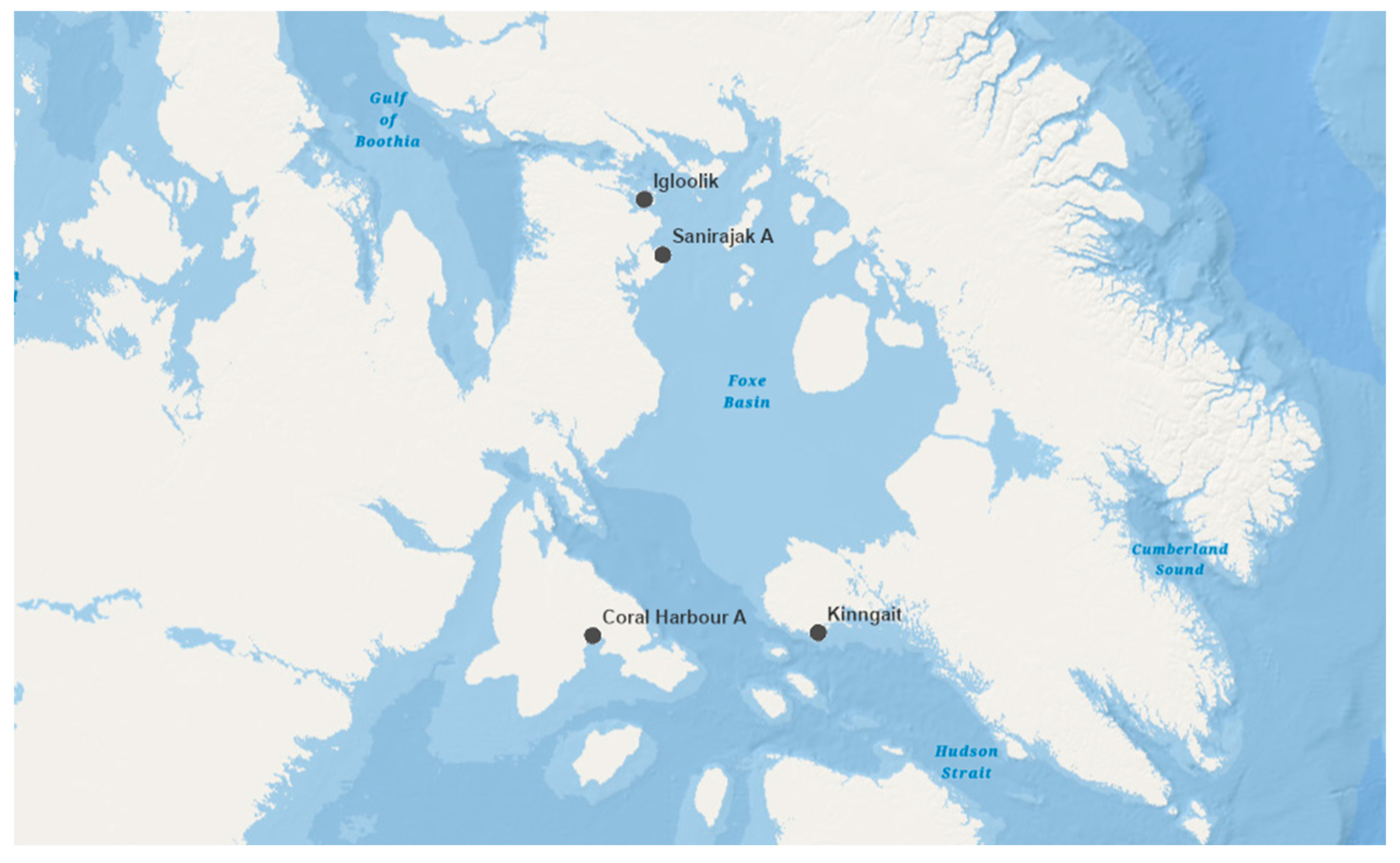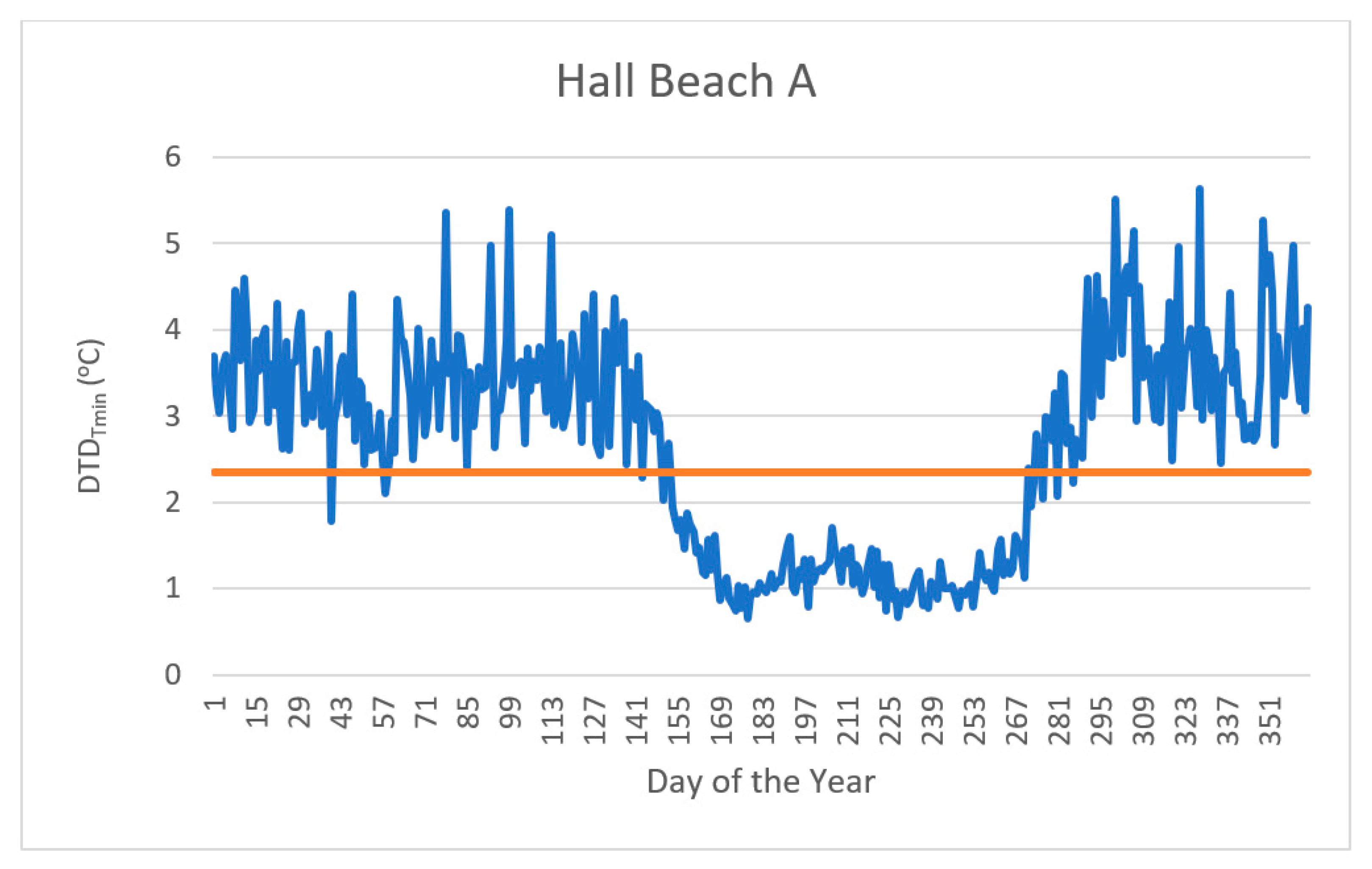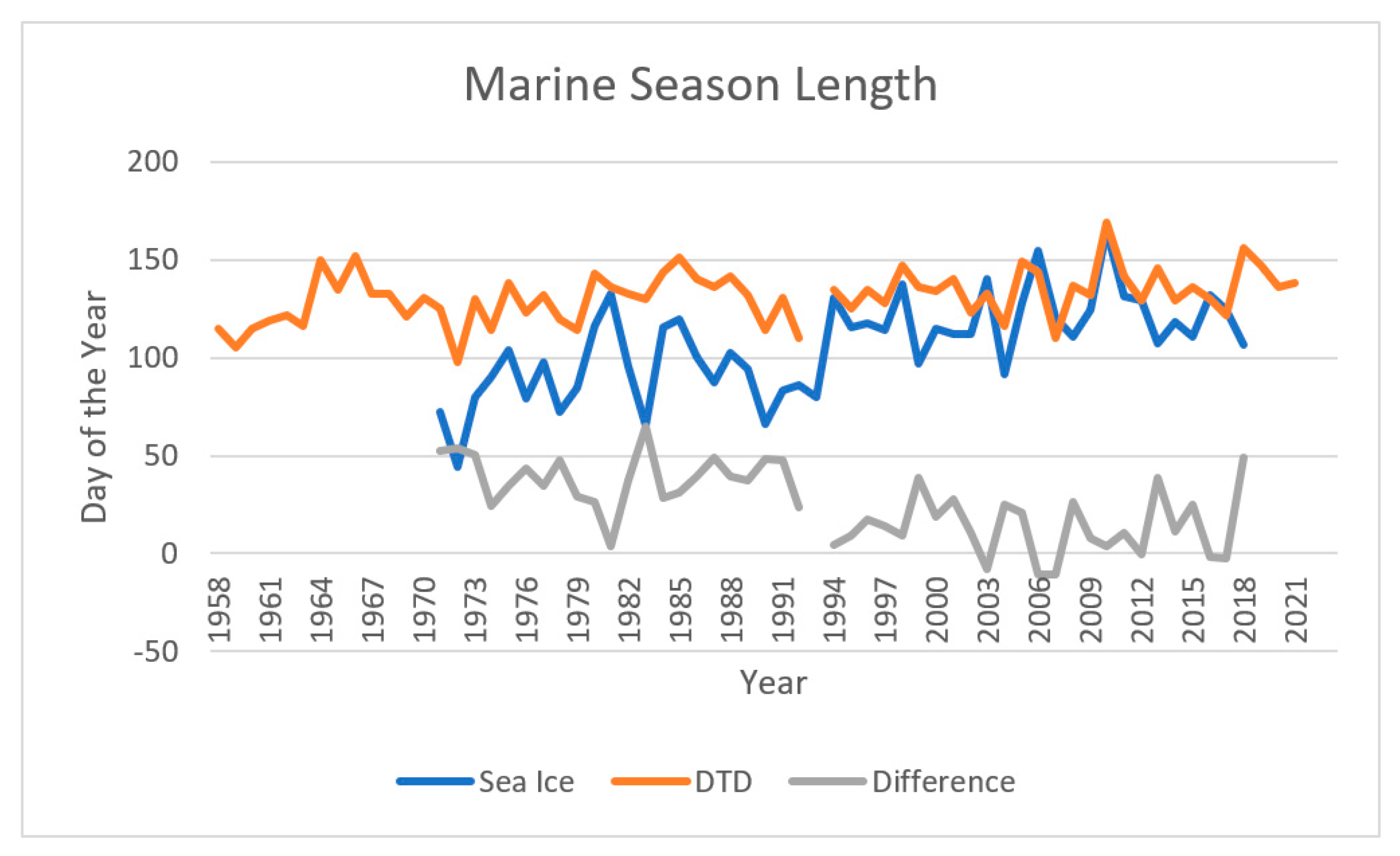A Marine Season Metric for Foxe Basin, Nunavut, Canada: Insights into the Evolving Nature of Sea-Ice Breakup and Freeze-Up
Abstract
1. Introduction
2. Materials and Methods
2.1. Surface Air Temperature Data
2.2. Sea-Ice Data
2.3. Marine Season Creation Using DTDTmin
2.3.1. DTDTmin Calculation
2.3.2. Marine Season
2.3.3. Comparison with Sea-Ice Data
2.3.4. Trend Analysis
3. Results
3.1. Marine Season
3.2. Comparison to Sea-Ice Chart Derived Metrics
3.3. Trend Analysis
4. Discussion
5. Conclusions
Funding
Institutional Review Board Statement
Informed Consent Statement
Data Availability Statement
Conflicts of Interest
References
- Laidler, G.J.; Ford, J.D.; Gough, W.A.; Ikummaq, T.; Gagnon, A.S.; Kowal, S. Travelling and hunting in a changing Arctic: Assessing Inuit vulnerability to sea ice change in Igloolik, Nunavut. Clim. Chang. 2009, 94, 363–397. [Google Scholar] [CrossRef]
- Gagnon, A.S.; Gough, W.A. East–west asymmetry in long-term trends of landfast ice thickness in the Hudson Bay region, Canada. Clim. Res. 2006, 32, 177–186. [Google Scholar] [CrossRef][Green Version]
- Galbraith, P.S.; Larouche, P. Sea-surface temperature in Hudson Bay and Hudson Strait in relation to air temperature and ice cover breakup, 1985–2009. J. Mar. Syst. 2011, 88, 463–475. [Google Scholar] [CrossRef]
- Hochheim, K.P.; Barber, D.G. An Update on the Ice Climatology of the Hudson Bay System. Arct. Antarct. Alp. Res. 2014, 46, 66–83. [Google Scholar] [CrossRef]
- Andrews, J.; Babb, D.G.; Barber, D.G. Climate change and sea ice: Shipping in Hudson Bay, Hudson Strait, and Foxe Basin (1980–2016). Elem. Sci. Anthr. 2018, 6, 19. [Google Scholar] [CrossRef]
- Kowal, S.; Gough, W.A.; Butler, K. Seasonal sea ice of Foxe Basin, Canada: Spatial and temporal evolution, 1971–2018. Elem. Sci. Anthr. 2024, 12, 1. [Google Scholar] [CrossRef]
- Landy, J.C.; Ehn, J.K.; Babb, D.G.; Theriault, N.; Barber, D.G. Sea ice thickness in the Eastern Canadian Arctic: Hudson Bay Complex and Baffin Bay. Remote Sens. Environ. 2017, 200, 281–294. [Google Scholar] [CrossRef]
- Bello, R.; Higuchi, K. Changing surface radiation and energy budgets of the Hudson Bay Complex using the North American regional reanalysis (NARR) model. Arct. Sci. 2019, 5, 218–239. [Google Scholar] [CrossRef]
- Defossez, M.; Saucier, F.J.; Myers, P.G.; Caya, D.; Dumais, J.-F. Multi-year observations of deep water renewal in Foxe Basin, Canada. Atmos.-Ocean 2008, 46, 377–390. [Google Scholar] [CrossRef]
- Defossez, M.; Saucier, F.J.; Myers, P.G.; Caya, D.; Dumais, J.-F. Analysis of a dense water pulse following mid-winter opening of polynyas in western Foxe Basin, Canada. Dyn. Atmos. Ocean. 2010, 49, 54–74. [Google Scholar] [CrossRef]
- Tivy, A.; Howell, S.E.L.; Alt, B.; McCourt, S.; Chagnon, R.; Crocker, G.; Yackel, J.J. Trends and variability in summer sea ice cover in the Canadian Arctic based on the Canadian Ice Service Digital Archive, 1960–2008 and 1968–2008. J. Geophys. Res. Ocean. 2011, 116, C03007. [Google Scholar] [CrossRef]
- Pizzolato, L.; Howell, S.E.; Derksen, C.; Dawson, J.; Copland, L. Changing sea ice conditions and marine transportation activity in Canadian Arctic waters between 1990 and 2012. Clim. Chang. 2014, 123, 161–173. [Google Scholar] [CrossRef]
- Pizzolato, L.; Howell, S.E.L.; Dawson, J.; Laliberté, F.; Copland, L. The influence of declining sea ice on shipping activity in the Canadian Arctic. Geophys. Res. Lett. 2016, 43, 12146–12154. [Google Scholar] [CrossRef]
- Andrews, J.; Babb, D.G.; Barber, D.G. Climate change and sea ice: Shipping accessibility on the marine transportation corridor through Hudson Bay and Hudson Strait (1980–2014). Elem. Sci. Anthr. 2017, 5, 1–17. [Google Scholar] [CrossRef]
- Barber, D.G.; Massom, R.A. The role of sea ice in Arctic and Antarctic polynyas. In Polynyas: Windows to the World. Elsevier Oceanogr. Ser. 2007, 74, 1–54. [Google Scholar]
- Gough, W.A. Thermal metrics for identifying Canadian coastal environments. Coasts 2022, 2, 93–101. [Google Scholar] [CrossRef]
- Gough, W.A.; Li, Z. Climate classification in the Canadian Prairie provinces using day-to-day thermal variability metrics. Atmosphere 2024, 15, 1111. [Google Scholar] [CrossRef]
- Gough, W.A. Theoretical considerations of day-to-day temperature variability applied to Toronto and Calgary, Canada data. Theor. Appl. Climatol. 2008, 94, 97–105. [Google Scholar] [CrossRef]
- Karl, T.R.; Knight, R.W.; Plummer, N. Trends in high frequency climate variability in the twentieth century. Nature 1995, 377, 217–220. [Google Scholar] [CrossRef]
- Gough, W.A.; Leung, A.C.W. Do airports have their own climate? Meteorology 2022, 1, 171–182. [Google Scholar] [CrossRef]
- Wu, F.-T.; Fu, C.; Qian, Y.; Gao, Y.; Wang, S.-Y. High frequency daily temperature variability in China and its relationship to large scale circulation. Int. J. Clim. 2017, 37, 570–582. [Google Scholar] [CrossRef]
- Tong, X.; Wang, P.; Wu, S.; Luo, M. Urbanization effects on high frequency temperature variability over South China. Urban Clim. 2022, 42, 101092. [Google Scholar] [CrossRef]
- Li, S.-F.; Jiang, D.-B.; Lian, Y.; Yao, Y.-X. Trends in day-to-day variability of surface air temperature in China during 1961–2012. Atmos. Ocean. Sci. Lett. 2017, 10, 122–129. [Google Scholar] [CrossRef]
- Xu, Z.; Huang, F.; Liu, Q.; Fu, C. Global pattern of historical and future changes in rapid temperature variability. Environ. Res. Lett. 2020, 15, 124073. [Google Scholar] [CrossRef]
- Liu, Q.; Fu, C.; Xu, Z. Revisiting two indices measuring high-frequency daily variability. Int. J. Climatol. 2024, 44, 2792–2807. [Google Scholar] [CrossRef]
- Onozuka, D.; Hagihara, A. Associations of day-to-day temperature change and diurnal temperature range with out-of-hospital cardiac arrest. Eur. J. Prev. Cardiol. 2017, 24, 204–212. [Google Scholar] [CrossRef] [PubMed]
- Hovdahl, I. The deadly effect of day-to-day temperature variation in the United States. Environ. Res. Lett. 2022, 17, 104031. [Google Scholar] [CrossRef]
- Savic, S.; Arsenovic, D.; Luzanin, Z.; Milosevic, D.; Dunjic, J.; Secerov, I.; Kojic, M.; Radic, I.; Harhaji, S.; Arsic, M. Hospital admission tendencies caused by day-to-day temperature changes during summer: A case study for the city of Novi Sad (Serbia). Int. J. Biometeorol. 2023, 67, 695–704. [Google Scholar] [CrossRef]
- Liu, Q.; Tan, Z.-M.; Sun, J.; Hou, Y.; Fu, C.; Wu, Z. Changing rapid weather variability increases influenza epidemic risk in a warming climate. Environ. Res. Lett. 2020, 15, 044004. [Google Scholar] [CrossRef]
- Guo, Y.; Barnett, A.G.; Yu, W.; Pan, X.; Ye, X.; Huang, C.; Tong, S. A large change in temperature between neighbouring days increases the risk of mortality. PLoS ONE 2011, 6, e16511. [Google Scholar] [CrossRef] [PubMed]
- Kotz, M.; Wenz, L.; Stechemesser, A.; Kalkuhl, M.; Levermann, A. Day-to-day temperature variability reduces economic growth. Nat. Clim. Chang. 2021, 11, 319–325. [Google Scholar] [CrossRef]
- Kinsenmeier, M. Temperature variability and long-run economic development. J. Environ. Econ. Manag. 2023, 121, 102840. [Google Scholar] [CrossRef]
- Garner, A.; Duran, D.P. Late-winter and springtime temperature variations throughout New Jersey in a warming climate. J. Appl. Meteorol. Climatol. 2024, 63, 197–207. [Google Scholar] [CrossRef]
- Pinskwar, I.; Chorynski, A.; Graczyk, D. Good weather for a ride (or not?): How conditions impact road accidents—A case study from Wielkopolska (Poland). Int. J. Biometeorol. 2024, 68, 317–331. [Google Scholar] [CrossRef] [PubMed]
- Stroeve, J.C.; Crawford, A.D.; Stammerjohn, S. Using timing of ice retreat to predict timing of fall freeze-up in the Arctic. Geophys. Res. Lett. 2016, 43, 6332–6340. [Google Scholar] [CrossRef]
- Gough, W.A. Reconstructing and hindcasting sea ice conditions in Hudson Bay using a thermal variability framework. Climate 2024, 12, 165. [Google Scholar] [CrossRef]





| Breakup | Freeze-Up | Period | |
|---|---|---|---|
| Gagnon & Gough (2006) [2] | −0.5 days/y | No trend | 1959–1989 |
| Laidler et al. (2009) [1] | −0.6 days/y | 0.6 days/y | 1982–2005 |
| Galbraith & Larouche (2010) [3] | −0.9 days/y | 0.9 days/y | 1990–2009 |
| Hochheim & Barber (2014) [4] | −0.7 days/y | 0.9 days/y | 1980–2010 |
| Andrews et al. (2018) [5] | −0.7 days/y | 0.6 days/y | 1980–2014 |
| Kowal et al. (2024) [6] | −0.4 days/y | 0.5 days/y | 1971–2018 |
| Station | Latitude | Longitude | Elevation | Period |
|---|---|---|---|---|
| Hall Beach A | 68.78 N | 81.24 W | 9.1 m | 1957–2014 |
| Sanirajak | 68.78 N | 81.24 W | 8.2 m | 2004–2023 |
| Igloolik | 69.38 N | 81.80 W | 21.3 m | 1977–2003 |
| Igloolik A | 69.37 N | 81.82 W | 52.7 m | 1984–2015 |
| Cape Dorset | 64.23 N | 76.53 W | 48.2 m | 1963–2012 |
| Coral Harbour A | 64.19 N | 83.36 W | 62.2 m | 1933–2015 |
| Year | Breakup SI | Onset DTD | Delta | Freezing SI | End DTD | Delta | SI IFS | MSL DTD | Delta |
|---|---|---|---|---|---|---|---|---|---|
| 1958 | 160 | 275 | 115 | ||||||
| 1959 | 169 | 274 | 105 | ||||||
| 1960 | 161 | 276 | 115 | ||||||
| 1961 | 153 | 272 | 119 | ||||||
| 1962 | 143 | 265 | 122 | ||||||
| 1963 | 158 | 274 | 116 | ||||||
| 1964 | 140 | 290 | 150 | ||||||
| 1965 | 149 | 284 | 135 | ||||||
| 1966 | 132 | 284 | 152 | ||||||
| 1967 | 152 | 285 | 133 | ||||||
| 1968 | 149 | 282 | 133 | ||||||
| 1969 | 158 | 279 | 121 | ||||||
| 1970 | 142 | 273 | 131 | ||||||
| 1971 | 212.5 | 147 | −65.5 | 285.0 | 272 | −13.0 | 72.5 | 125 | 52.5 |
| 1972 | 220.1 | 172 | −48.1 | 264.5 | 270 | 5.5 | 44.4 | 98 | 53.6 |
| 1973 | 207.4 | 149 | −58.4 | 287.3 | 279 | −8.3 | 79.8 | 130 | 50.2 |
| 1974 | 204.4 | 160 | −44.4 | 294.3 | 274 | −20.3 | 89.9 | 114 | 24.1 |
| 1975 | 194.6 | 146 | −48.6 | 298.3 | 284 | −14.3 | 103.6 | 138 | 34.4 |
| 1976 | 197.2 | 166 | −31.2 | 276.6 | 289 | 12.4 | 79.4 | 123 | 43.6 |
| 1977 | 199.4 | 150 | −49.4 | 296.9 | 282 | −14.9 | 97.5 | 132 | 34.5 |
| 1978 | 192.0 | 164 | −28.0 | 264.5 | 284 | 19.5 | 72.5 | 120 | 47.5 |
| 1979 | 199.6 | 158 | −41.6 | 284.6 | 272 | −12.6 | 85.0 | 114 | 29.0 |
| 1980 | 183.6 | 138 | −45.6 | 300.0 | 281 | −19.0 | 116.4 | 143 | 26.6 |
| 1981 | 177.3 | 154 | −23.3 | 309.8 | 290 | −19.8 | 132.5 | 136 | 3.5 |
| 1982 | 195.3 | 142 | −53.3 | 291.0 | 275 | −16.0 | 95.7 | 133 | 37.3 |
| 1983 | 204.9 | 148 | −56.9 | 270.3 | 278 | 7.7 | 65.4 | 130 | 64.6 |
| 1984 | 186.3 | 151 | −35.3 | 301.7 | 295 | −6.7 | 115.4 | 144 | 28.6 |
| 1985 | 184.6 | 134 | −50.6 | 304.4 | 285 | −19.4 | 119.8 | 151 | 31.3 |
| 1986 | 185.7 | 151 | −34.7 | 286.4 | 291 | 4.6 | 100.7 | 140 | 39.3 |
| 1987 | 192.2 | 155 | −37.2 | 279.4 | 291 | 11.6 | 87.2 | 136 | 48.8 |
| 1988 | 182.8 | 138 | −44.8 | 285.2 | 280 | −5.2 | 102.3 | 142 | 39.7 |
| 1989 | 185.4 | 148 | −37.4 | 279.9 | 280 | 0.1 | 94.5 | 132 | 37.5 |
| 1990 | 203.2 | 155 | −48.2 | 269.1 | 269 | −0.1 | 65.9 | 114 | 48.1 |
| 1991 | 192.2 | 157 | −35.2 | 275.9 | 288 | 12.1 | 83.7 | 131 | 47.3 |
| 1992 | 191.7 | 162 | −29.7 | 278.1 | 272 | −6.1 | 86.4 | 110 | 23.6 |
| 1993 | 200.6 | 280.5 | 79.9 | ||||||
| 1994 | 174.6 | 141 | −33.6 | 305.0 | 276 | −29.0 | 130.5 | 135 | 4.5 |
| 1995 | 180.4 | 151 | −29.4 | 296.0 | 276 | −20.0 | 115.6 | 125 | 9.4 |
| 1996 | 186.0 | 158 | −28.0 | 303.4 | 293 | −10.4 | 117.4 | 135 | 17.6 |
| 1997 | 186.2 | 155 | −31.2 | 300.5 | 283 | −17.5 | 114.3 | 128 | 13.7 |
| 1998 | 179.6 | 149 | −30.6 | 317.1 | 296 | −21.1 | 137.5 | 147 | 9.5 |
| 1999 | 189.2 | 145 | −44.2 | 286.5 | 281 | −5.5 | 97.3 | 136 | 38.7 |
| 2000 | 198.2 | 159 | −39.2 | 313.2 | 293 | −20.2 | 115.0 | 134 | 19.0 |
| 2001 | 188.2 | 145 | −43.2 | 300.4 | 285 | −15.4 | 112.3 | 140 | 27.8 |
| 2002 | 188.2 | 154 | −34.2 | 300.4 | 277 | −23.4 | 112.2 | 123 | 10.8 |
| 2003 | 175.0 | 141 | −34.0 | 315.6 | 274 | −41.6 | 140.6 | 133 | −7.6 |
| 2004 | 196.2 | 161 | −35.2 | 287.5 | 277 | −10.5 | 91.3 | 116 | 24.8 |
| 2005 | 186.3 | 152 | −34.3 | 314.3 | 301 | −13.3 | 128.0 | 149 | 21.0 |
| 2006 | 172.8 | 136 | −36.8 | 327.6 | 280 | −47.6 | 154.8 | 144 | −10.8 |
| 2007 | 182.5 | 159 | −23.5 | 303.0 | 269 | −34.0 | 120.5 | 110 | −10.5 |
| 2008 | 193.8 | 136 | −57.8 | 304.3 | 273 | −31.3 | 110.5 | 137 | 26.5 |
| 2009 | 183.0 | 154 | −29.0 | 307.3 | 286 | −21.3 | 124.3 | 132 | 7.7 |
| 2010 | 172.4 | 137 | −35.4 | 337.5 | 306 | −31.5 | 165.1 | 169 | 3.9 |
| 2011 | 181.6 | 149 | −32.6 | 313.2 | 291 | −22.2 | 131.5 | 142 | 10.5 |
| 2012 | 181.2 | 151 | −30.2 | 310.4 | 280 | −30.4 | 129.2 | 129 | −0.2 |
| 2013 | 192.9 | 147 | −45.9 | 300.3 | 293 | −7.3 | 107.3 | 146 | 38.7 |
| 2014 | 189.0 | 147 | −42.0 | 307.1 | 276 | −31.1 | 118.1 | 129 | 10.9 |
| 2015 | 183.1 | 149 | −34.1 | 294.2 | 285 | −9.2 | 111.1 | 136 | 24.9 |
| 2016 | 182.6 | 148 | −34.6 | 314.5 | 278 | −36.5 | 131.8 | 130 | −1.8 |
| 2017 | 187.0 | 152 | −35.0 | 311.3 | 274 | −37.3 | 124.3 | 122 | −2.3 |
| 2018 | 177.6 | 138 | −39.6 | 284.4 | 294 | 9.6 | 106.8 | 156 | 49.2 |
| 2019 | 142 | 289 | 147 | ||||||
| 2020 | 155 | 291 | 136 | ||||||
| 2021 | 154 | 292 | 138 | ||||||
| 2022 | |||||||||
| 2023 | 153 | 283 | 130 |
| M-K p-Value | LR p-Value | Rate of Change | Range | |
|---|---|---|---|---|
| Onset | 0.12 | 0.06 | −0.17 days/y | 1971–2018 |
| Breakup | 0.0001 *** | <0.0001 *** | −0.43 days/y | 1971–2018 |
| Difference Onset | 0.02 * | 0.006 ** | −0.27 days/y | 1971–2018 |
| End | 0.24 | 0.20 | 0.12 days/y | 1971–2018 |
| Freeze-up | 0.0001 *** | 0.0001 *** | 0.64 days/y | 1971–2018 |
| Difference End | 0.0005 *** | 0.0007 *** | 0.52 days/y | 1971–2018 |
| MSL | 0.11 | 0.03 * | 0.28 days/y | 1971–2018 |
| IFS | 0.00004 *** | <0.0001 *** | 1.07 days/y | 1971–2018 |
| Difference MSL | 0.00004 *** | <0.0001 *** | 0.78 days/y | 1971–2018 |
| Onset | 0.17 | 0.13 | −0.09 days/y | 1957–2023 |
| End | 0.01 ** | 0.005 ** | 0.15 day/y | 1957–2023 |
| MSL | 0.01 ** | 0.004 ** | 0.24 days/y | 1957–2023 |
Disclaimer/Publisher’s Note: The statements, opinions and data contained in all publications are solely those of the individual author(s) and contributor(s) and not of MDPI and/or the editor(s). MDPI and/or the editor(s) disclaim responsibility for any injury to people or property resulting from any ideas, methods, instructions or products referred to in the content. |
© 2025 by the author. Licensee MDPI, Basel, Switzerland. This article is an open access article distributed under the terms and conditions of the Creative Commons Attribution (CC BY) license (https://creativecommons.org/licenses/by/4.0/).
Share and Cite
Gough, W.A. A Marine Season Metric for Foxe Basin, Nunavut, Canada: Insights into the Evolving Nature of Sea-Ice Breakup and Freeze-Up. Coasts 2025, 5, 7. https://doi.org/10.3390/coasts5010007
Gough WA. A Marine Season Metric for Foxe Basin, Nunavut, Canada: Insights into the Evolving Nature of Sea-Ice Breakup and Freeze-Up. Coasts. 2025; 5(1):7. https://doi.org/10.3390/coasts5010007
Chicago/Turabian StyleGough, William A. 2025. "A Marine Season Metric for Foxe Basin, Nunavut, Canada: Insights into the Evolving Nature of Sea-Ice Breakup and Freeze-Up" Coasts 5, no. 1: 7. https://doi.org/10.3390/coasts5010007
APA StyleGough, W. A. (2025). A Marine Season Metric for Foxe Basin, Nunavut, Canada: Insights into the Evolving Nature of Sea-Ice Breakup and Freeze-Up. Coasts, 5(1), 7. https://doi.org/10.3390/coasts5010007





